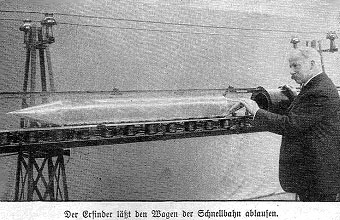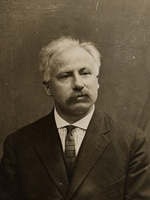France / United States of America
Emile Bachelet was born in France in 1863. His invention is one of the premier and fundamental predecessors of the technologies surrounding modern electromagnetically levitated trains.
In 1914, the French-born American inventor Emile Bachelet presented his idea of a maglev vehicle and even displayed a first model. A report in the Swiss journal "Schwizer Familie" in the year 1914 shows a photograph of this event and provides some information about his project vision, as well as the model.

Emile Bachelet, 1914, with his maglev model. Source: "Schwizer Familie" No. 35, June 27, 1914.
Emile Bachelet was born in France in 1863. He emigrated in the 1880s to the United States where he worked as an electrician. In this activity he discovered some therapeutic applications of electro-magnets to cure rheumatism and relieve arthritic pain.
After starting in the 1890s to commercially exploit related medical devices for which he was granted several patents, he began work on magnetic forces through electro-magnets. It is easy to understand what is involved by thinking of what can be done with natural magnets: when the north pole of a magnet faces the south pole of another magnet an attraction force is created; in reverse, a magnetic repulsion is obtained by opposing two north poles or two south poles. Electro-magnets, according to the intensity of the current and turning on and off at the desired frequency, allow the creation and control of a powerful magnetic force.
In March 1912, Bachelet obtained a patent for a “levitating transmitting apparatus” from the United States Patent Office (patent no. 1,020,942). The invention is described as a machine to transfer bodies at a very high speed from one point to another.
Although it was primarily meant for the transmission of mail and small packages by a carrier, it was easy to imagine its application at a larger scale in trains carrying freight or passengers.
Photographer unknown. Emile Bachelet in his laboratory standing next to his working model of the magnetically levatated railway. Source: Emile Bachelet Collection, Archives Center, National Museum of American History (Accessed: 09-03.2021)
Using the forces of magnetic attraction and repulsion, Bachelet explained in detail how to arrange the magnets, with their poles, on a pathway and on the carrier and how to energise them (periodically) so as to create magnetic fields and allow the carrier to move through these fields. A first magnetic field is designed to levitate the carrier, which is made of a non-magnetic metal but which hold its own set of magnets that react with the magnetic field of the pathway. It then “floats” in the air and can be propelled like a plane without mechanical friction. Another magnetic field is used to make the carrier move along with another series of magnets that are activated to attract other magnets on board the carrier (the repulsion/attraction pushing the carrier forward) while it is levitated (although this propulsion could also be obtained by classical means). Finally, the guidance of the carrier along the pathway can also be controlled using a third magnetic field.
Too far ahead of his time?
Bachelet was quite successful as early as 1914 with a prototype in an exhibition in London and managed to attract financial support to continue his research until his death in 1946. This invention is one of the premier and fundamental predecessors of the technologies surrounding modern electromagnetically levitated trains (or so-called ‘Maglev’ trains for ‘magnetic levitation’).
Emlie Bachelet (center with his arms elongated), demonstrates and explains to visitors how his magnetically levitated railway works. This takes place at his laboratory in Great Saffron Hall, Hobborn Circus, London, Circa 1914.
Source: Emile Bachelet Collection, Archives Center, National Museum of American History (Accessed: 09-03.2021)
Bachelet was probably too far ahead of his time. Although the patent described details such as how to savae electricity by activating the magnets just before the passage of the train and cut the current after it has passed, it should be recalled that, at that time, the development of electric locomotives functioning on a reliable and powerful source of electricity to propel real commercial freight or passenger trains that would later overcome steam locomotivs had not even begun. In addition, the system required, and still requires nowadays, the construction of a specific network. Nevertheless, Bachelet’s invention undoubtedly paved the way for modern maglev trains, like the Chinese Transrapid of Shanghai or the Japanese Linimo of Aichi.
(Biography info based on http://www.ipr-helpdesk.org, Accessed 01.04.2009).




